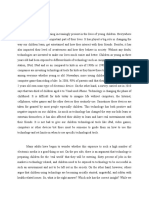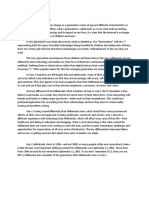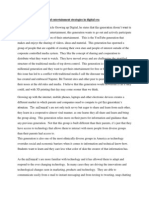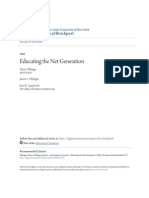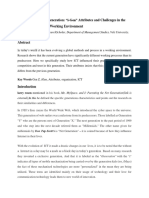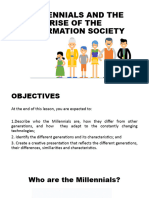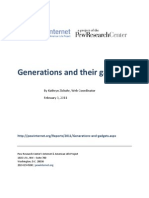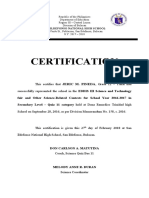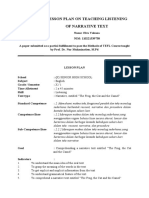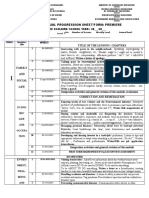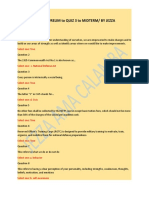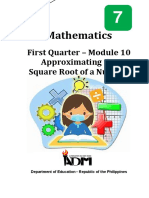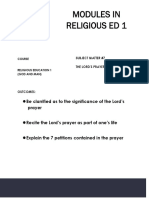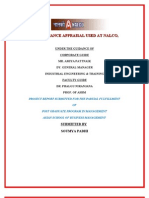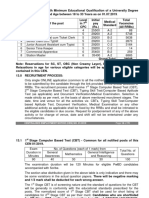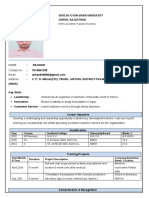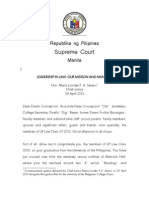Designing Motivation for All Learners Articles
Teaching the iGeneration
by Larry D. Rosen
Source: “Teaching the iGeneration,” by Larry D. Rosen, 2011, Educational Leadership, 68(5), pp. 10-15.
© 2011 by ASCD. Reprinted with permission. Learn more about ASCD at www.ascd.org.
Our children and youth are immersed in These stories give me hope for our current and
technologies that give them opportunities future generations of learners. To them, the
smartphone, the Internet, and everything
no previous generation has enjoyed. How technological are not “tools” at all—they simply are.
will schools respond? Just as we don’t think about the existence of air, they
don’t question the existence of technology and media.
Some weeks ago, I attended a family reunion
They expect technology to be there, and they expect it
where the children ranged from age 10 to 18. As we
to do whatever they want it to do. Their WWW
were all talking, someone asked a question about a
doesn’t stand for World Wide Web; it stands for
specific movie. Immediately, every kid pulled out a
Whatever, Whenever, Wherever.
smartphone, and within 30 seconds they all had
answers. Some went straight to the Internet Movie
Database (using a smartphone app, of course); two New Generations
quickly searched Yahoo! for movie reviews; others Studying generational similarities and differences
went to their favorite sites to sample public opinion. can be tricky; no individual completely fits the profile
I’ve seen adults do something similar and gloat of a particular generation. But research suggests that
about how Internet-savvy they are and how fast their the majority of people born between a rough set of
smartphones navigate cyberspace. But each and every dates actually do share many characteristics (see
kid acted like this practice was commonplace. Strauss & Howe, 1991).
A few days later, I had another enlightening Those born between about 1925 and 1946 are
experience. A colleague’s 7-year-old son, Mikey, has often called the Traditional or Silent generation.
his own iPad courtesy of his grandpa. A week ago, he Growing up through the Great Depression, World
was visiting our lab and wanted to print something War II, and the Cold War, they are characterized by a
from his iPad. His dad said that he would have to wait belief in common goals and respect for authority. The
until he got home because although our new printer Baby Boomer generation, born between 1946 and
had Bluetooth access, nobody had yet figured out 1964, tends to be optimistic, idealistic, and
how to make it work. Mikey got to work and had his communicative and to value education and consumer
document printing in 10 minutes. goods. The next generation, born between 1965 and
My colleague told me that when the family 1979, were defined by Douglas Coupland (1991) as
decided to upgrade the computer operating system at Generation X in his book of the same name; the label
home, Mikey volunteered to do it. In an hour, all the X signifies that, compared with the Baby Boomers,
laptops in the house had the new operating system. I Gen Xers are not as easily categorized.
could go on and on about Mikey’s prowess, but his With the 1980s and the birth of the World Wide
dad assures me that he is just like all his friends; Web, the power of cyberspace came to the masses
although he’s smart, his comfort and ease in using and a new generation of web surfers, very different
technology are nothing special. from their predecessors, was born. The most common
One last story, about an even younger child. I was label for this generation is Generation Y, simply
at a restaurant the other night and watched a mom meaning the generation after X. Some people stretch
hand her daughter her iPhone to keep her occupied. this generation past 1999 and refer to its members as
The mom later told me that she expected 3-year-old Millennials. To me, these names are an insult to our
Brittani to play one of several built-in games, as she first true cybergeneration. This generation should not
had done a couple of times before. To her surprise, be defined by the next letter in the alphabet or by the
Brittani asked whether she could download a game turn of the century. I believe that Don Tapscott’s
from the app store. When her mom said yes and (1999) term—the Net Generation—better reflects the
showed her the link, she tapped the icon, watched the impact of the Internet on the lives of its members.
game load, and without hesitation began playing. On the basis of our research with thousands of
teenagers and their parents, my colleagues and I have
Articles 33
�Articles Designing Motivation for All Learners
identified a separate generation, born in the 1990s Consuming a Massive Media Diet
and beyond, which we label the iGeneration. The i In our studies of thousands of children and teens
represents both the types of digital technologies at the George Marshall Applied Cognition
popular with children and adolescents (iPhone, iPod, Laboratory, my colleagues and I have found that the
Wii, iTunes, and so on) and the highly individualized iGeneration consumes massive quantities of media. In
activities that these technologies make possible. anonymous online surveys, we ask young people how
Children and youth in this new generation are defined much they engage in a variety of activities, including
by their technology and media use, their love of being online, using computers offline, listening to
electronic communication, and their need to music, playing video games, talking on the telephone,
multitask. instant messaging, texting, sending and receiving e-
Parenthetically, we are just starting to examine a mail, and watching television (see fig. 1).
separate minigeneration of kids like Mikey and Our work and that of others, including the Kaiser
Brittani, who not only are facile with individualized Family Foundation and the Pew Internet and
mobile technologies, but also have the expectation American Life Project (Lenhart, Ling, Campbell, &
that if they conceive of something, they should be Purcell, 2010; Rideout, Foehr, & Roberts, 2010),
able to make it happen. If an app doesn’t exist for suggest that both the Net Generation and the
something they want to do on a smartphone, they just iGeneration’s older teen group are consuming
assume that nobody has created it yet and that it massive amounts of media. Figure 1 gives the total
should be a piece of cake to do so. All in all, a amount of reported hours of media use for four
fascinating minigeneration. generations. Even considering the fact that
Figure 1. Hours Per Day of Media
Use by Age Group
34 Articles
�Designing Motivation for All Learners Articles
respondents are doing many of these media activities technology to convey content more powerfully and
simultaneously, it appears that many children and efficiently.
teens spend nearly all their waking hours using media Teachers can access an enormous amount of
and technology. curriculum content online in a variety of formats,
Our studies have also found clear differences in including audio and video pieces that can help bring
what each generation does with its technology. Baby the material to life for students. These materials are
Boomers, in general, prefer face-to-face or telephone often free. Helpful sites include
communication, although many use e-mail regularly.
• Discovery Education’s Lesson Plan Library
Gen Xers—being the ambiguous, transitional
(http://school.discoveryeducation.com/lessonplans)
generation that they are—seem to embrace both cell
phones and e-mail, with a bit of instant messaging • Teachers Helping Teachers
thrown in. The Net Generation began to carve out a (www.pacificnet.net/~mandel/index.html)
new communication era, using many available
• TeachersFirst.com
technologies, including social networks like
(www.teachersfirst.com/index.cfm)
Facebook, instant messages, Skype, and texting.
Then we have the iGeneration, which redefined • Thinkfinity (www.thinkfinity.org/lesson-plans)
communication. According to the Nielsen company,
which tracks a large sample of teens on a quarterly When I talk to teachers, the first comment I often
basis, the typical teenager sends and receives an hear is, “How can I find time to locate and organize
incredible 3,339 texts a month (which translates into all these online sources?” One answer is to use a
more than 6 messages every hour that he or she is not knowledge broker—someone who helps you identify
sleeping) while making and receiving only 191 phone online resources. Your knowledge broker can be a
calls during that same period. Two years ago, teens tech-savvy older student, a local community college
sent and received about the same number of texts as student, or even a parent. Give the knowledge broker
phone calls (Nielsen Wire, 2010). the task of identifying possible resources that you can
To members of the iGeneration, a phone is not a use to support your curriculum.
phone. It is a portable computer that they use to Recently, for example, I worked with a high
tweet, surf the web, and, of course, text, text, text. school history teacher who wanted to locate content
that would help her teach a unit on the last year of
How Schools Need to Respond World War II. We identified an honors student who
Watch typical teens or preteens at home, and you had already taken the course and asked him to find a
will see them constantly switching between their collection of audio files, videos, websites, and any
laptop, cell phone, television, MP3 player, and video other online material related to this topic. A week
game console with apparent ease. In school, we later, the student returned with links to several
require them to unitask by listening to the teacher, YouTube videos with original wartime footage, photo
completing worksheets, writing with pen and paper, collections, podcasts, and other multimedia
or engaging in other solitary activities. There are presentations on events that occurred during that year.
better ways of teaching our students. He worked with the teacher to help her become
Of course, using technology to enhance education proficient at using each of the content tools. When the
doesn’t mean that we should move classes totally teacher assigned her class to watch and listen to
online. Students need face-to-face social interaction, several of those videos and other multimedia
especially in the primary and middle school grades. It presentations, the knowledge broker stood by to help
doesn’t mean that teachers should simply assign work make sure that the class (and the teacher) could
on computers and let students find their own way. It access the resources effectively.
doesn’t mean providing technology in the classroom The resources included videos for those who
for technology’s sake. Interactive whiteboards and learned by more kinesthetic and auditory modalities,
desktop computers often sit unused by teachers who written newspaper reports for those who learned best
did not want them and who were not trained to use by visual modalities, and even interactive websites
them. for those with a more tactile and kinesthetic learning
Nor should teachers feel responsible for finding style. Providing information through a variety of
educational technologies to use in their classrooms. modalities and sources helped students develop a
Teachers are required to teach specific content. The richer, more complex mental representation of the
point is not to “teach with technology” but to use material.
Articles 35
�Articles Designing Motivation for All Learners
Demonstration projects around the United States Johnson, L., Smith, R., Levine, A., & Haywood, K.
have found that once teachers relegate much of the (2010). 2010 Horizon report: K–12 edition.
content dissemination to technology, they can spend Austin, TX: New Media Consortium.
class time more productively— helping students Lenhart, A., Ling, R., Campbell, S., & Purcell, K.
analyze, synthesize, and assimilate material (Johnson, (2010). Teens and mobile phones. Retrieved
Smith, Levine, & Haywood, 2010; Project from Pew Research Center’s Internet and
Tomorrow, 2010). After all, isn’t this the most American Life Project at
effective use of class time and teacher talent? www.pewinternet.org/Reports/2010/Teens-and-
For example, suppose you want your students to Mobile-Phones.aspx
watch and discuss Act I of Hamlet. Instead of
showing the video in class, you might have them Nielsen Wire. (2010, October 14). U.S. teen mobile
watch it on YouTube as a homework assignment. Not report: Calling yesterday, texting today, using
only will they be engaged in a modality they use apps tomorrow [blog post]. Retrieved from
constantly, but they will also be able to access the Nielsenwire at
video 24/7—they can watch and rewatch it on their http://blog.nielsen.com/nielsenwire/online_mobi
own schedule. After they view the video once, you le/u-s-teen-mobile-report-calling-yesterday-
can use class time to help them deconstruct Act I and texting-today-using-apps-tomorrow
then send them back to watch it again—which they Project Tomorrow. (2010). Learning in the 21st
are more likely to do than if you send them back to century: 2010 trends update. Irvine, CA:
reread the text. Author.
Rideout, V. J., Foehr, U. G., & Roberts, D. F. (2010).
Leading Education into the Future Generation M2: Media in the lives of 8- to 18-
Technology is all about engagement. Watching year-olds. Retrieved from Kaiser Family
the intense looks on our children’s and teens’ faces as Foundation at
they play video games, text all day long, Skype, www.kff.org/entmedia/upload/8010.pdf
Facebook, watch YouTube videos, and juggle a
Strauss, W., & Howe, N. (1991). Generations: The
dozen websites at a time, we can clearly see that they
history of America’s future, 1584–2069. New
are engaged.
York: William Morrow.
The iGeneration is immersed in technology. Their
tech world is open 24/7. Now, we need to take Tapscott, D. (1999). Growing up digital: The rise of
advantage of their love of technology to refocus the Net Generation. New York: McGraw-Hill.
education. In doing so, we’ll not only get students
more involved in learning, but also free up classroom Larry D. Rosen is professor of psychology at California State
time to help them make meaning of the wealth of University, Dominguez Hills; LROSEN@csudh.edu. His two
most recent books are Me, MySpace, and I: Parenting the Net
information that surrounds them. Generation (Palgrave Macmillan, 2007) and Rewired:
Understanding the iGeneration and the Way They Learn
(Palgrave Macmillan, 2010).
References
Coupland, D. (1991). Generation X: Tales for an
accelerated culture. New York: St. Martin’s
Griffin.
36 Articles



